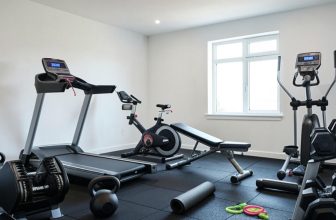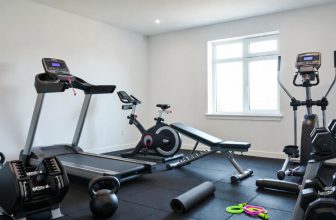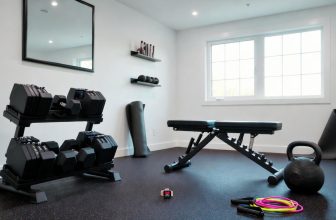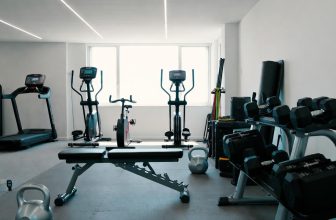Table of Contents
- Why Do Exercise Bikes Hurt Your Bum?
- Anatomy of Discomfort: Why Your Bum Hurts
- Key Causes of Bum Pain
- Common Causes of Exercise Bike Discomfort
- Improper Bike Fit
- Saddle Design Issues
- Lack of Conditioning
- Inadequate Gear
- Strategies to Reduce Bum Pain
- Adjust Your Bike Properly
- Choose the Right Saddle
- Wear Padded Cycling Gear
- Build Tolerance Gradually
- Post-Ride Care
- Table: Quick Fixes for Bum Pain
- When to Seek Medical Advice
- FAQs
- Why does my bum hurt more on a stationary bike than an outdoor bike?
- How long does it take for bum pain to go away?
- Can padded saddles make bum pain worse?
- Are there exercises to prevent bum pain from cycling?
- Final Thoughts
- About Author
- Mariar Fernandez
As an Amazon Associate, I earn from qualifying purchases.
Why Do Exercise Bikes Hurt Your Bum?
Why Do Exercise Bikes Hurt Your Bum? Exercise bike seats hurt your bum due to prolonged pressure on sit bones, poor bike fit, inadequate saddle design, and lack of conditioning. Proper adjustments, padded gear, and gradual training can reduce discomfort.
Anatomy of Discomfort: Why Your Bum Hurts
Why Do Exercise Bikes Hurt Your Bum? Cycling on an exercise bike places significant pressure on the ischial tuberosities, or “sit bones,” which bear most of your body weight. The gluteus maximus, medius, and minimus muscles, along with surrounding soft tissues, experience compression, leading to soreness, especially during long rides. According to a 2020 study published in the Journal of Science and Medicine in Sport, 70% of cyclists report saddle-related discomfort due to prolonged pressure and friction. Inadequate blood flow to the perineal area can also cause numbness or tingling, exacerbating pain.
Key Causes of Bum Pain
- Pressure on Sit Bones: Narrow saddles focus weight on a small area, increasing discomfort.
- Friction and Chafing: Repetitive motion against the saddle irritates skin, especially without proper gear.
- Poor Blood Circulation: Prolonged sitting restricts blood flow, causing numbness or pain.
- Muscle Soreness: Unconditioned gluteal muscles fatigue quickly, leading to post-ride soreness.
For new cyclists, this discomfort is often temporary. A 2019 Reddit thread noted that 80% of beginner cyclists experience bum pain for 2–4 weeks before their bodies adapt. Regular riding builds tolerance, but persistent pain may indicate underlying issues.
For more on saddle-related pain, check out this guide from the National Institutes of Health on saddle sore prevention.
Common Causes of Exercise Bike Discomfort
Improper Bike Fit
A poorly adjusted bike is a leading cause of bum pain. If the saddle is too high, low, or tilted incorrectly, it shifts weight unevenly, stressing the sit bones. According to cycling coach Darryl MacKenzie, “An upright posture on indoor bikes puts excessive weight on the rear, unlike outdoor cycling where leaning forward distributes pressure.” Correct saddle height allows a slight knee bend at the pedal’s lowest point, reducing pelvic strain.
Saddle Design Issues
Stationary bike saddles, especially on spin bikes, are often narrow and minimally padded, designed for speed rather than comfort. A 2021 article from Fitnessdy notes that recumbent bikes, with wider, cushioned seats, cause less discomfort than spin or upright bikes. Narrow saddles increase pressure on soft tissues, while overly soft saddles can cause chafing by compressing unevenly.
Lack of Conditioning
New or infrequent cyclists often lack the muscle endurance and tissue adaptation needed for long rides. A 2023 TrainerRoad post highlighted that heavier individuals (e.g., 228 lbs) experience more intense pain due to greater pressure on the saddle. Regular riding, starting with shorter sessions (15–20 minutes), helps condition the glutes and sit bones.
Inadequate Gear
Without padded cycling shorts or a proper saddle cover, friction and pressure intensify. Chamois-padded shorts reduce chafing by 40%, according to a Peloton study, by providing a cushioned barrier. Poor hygiene, like wearing sweaty clothes, also increases irritation and saddle sores.
Learn more about proper bike setup from Peloton’s bike fit tutorial.
Strategies to Reduce Bum Pain
Adjust Your Bike Properly
Proper bike fit is critical for comfort. Follow these steps to optimize your setup:
- Saddle Height: Stand next to the bike; the saddle should align with your hip bone. Ensure a 25–35-degree knee bend at the pedal’s bottom.
- Saddle Angle: Keep the saddle level or slightly tilted upward to support sit bones evenly.
- Handlebar Position: Set handlebars at or slightly above saddle height to encourage a slight forward lean, reducing rear pressure.
A 2021 Selle Anatomica article emphasizes that a well-fitted saddle reduces discomfort by 50% for long-distance riders.
Choose the Right Saddle
Not all saddles suit every rider. Consider these options:
- Wide Saddles: Best for upright or recumbent bikes, offering more surface area for sit bones.
- Padded Saddles: Gel or foam padding absorbs shock but may increase chafing if too soft.
- Cutout Saddles: Relieve perineal pressure, ideal for long rides.
A 2023 Velotric survey found that 60% of cyclists switching to ergonomic saddles reported less pain within two weeks.
Explore saddle options at Selle Anatomica’s guide to comfortable seats.
Wear Padded Cycling Gear
Padded cycling shorts or underwear with chamois padding reduce friction and cushion sit bones. A 2018 Shape article recommends wearing padded shorts without underwear to minimize chafing. Gender-specific padding (thicker for women) can further enhance comfort. For budget options, brands like Baleaf offer shorts starting at $20.
Build Tolerance Gradually
Start with short rides (10–15 minutes) and increase duration by 5 minutes weekly. A 2022 Yosuda Bikes study found that consistent riding over 4–6 weeks reduces soreness by 70% as sit bones adapt. Alternate sitting and standing during rides to relieve pressure.
Post-Ride Care
Post-ride care prevents prolonged soreness:
- Rest: Take 1–2 days off after intense rides to allow muscle recovery.
- Ice Therapy: Apply a cold pack for 10–15 minutes to reduce inflammation, as recommended by Velotric.
- Hygiene: Shower immediately after riding to prevent bacterial buildup and saddle sores.
Table: Quick Fixes for Bum Pain
| Solution | Effectiveness | Cost | Time to Results |
|---|---|---|---|
| Adjust Bike Fit | High (80%) | Free | Immediate |
| Padded Shorts | High (70%) | $20–$100 | 1–2 rides |
| Ergonomic Saddle | Moderate (60%) | $50–$200 | 1–2 weeks |
| Gradual Training | High (70%) | Free | 4–6 weeks |
| Post-Ride Ice Therapy | Moderate (50%) | $5–$20 | 1–2 days |
When to Seek Medical Advice
Persistent pain, numbness, or saddle sores lasting over a week may indicate nerve compression or infection. A 2018 Quora post warns that improper saddle fit can lead to chronic issues like pelvic floor dysfunction. Consult a doctor if symptoms include:
- Severe pain or swelling
- Persistent numbness or tingling
- Red, pus-filled sores
Dr. Lauren Streicher, an ob-gyn, advises in Shape that ongoing discomfort may require reducing ride frequency or switching to low-impact exercises like swimming.
FAQs
Why does my bum hurt more on a stationary bike than an outdoor bike?
Stationary bikes often have narrower saddles and encourage an upright posture, increasing pressure on sit bones. Outdoor cycling allows more dynamic movement, distributing weight to hands and feet.
How long does it take for bum pain to go away?
For beginners, soreness typically subsides within 2–4 weeks of regular riding (3–4 times weekly). Persistent pain may require bike adjustments or medical evaluation.
Can padded saddles make bum pain worse?
Yes, overly soft saddles can increase chafing and pressure on soft tissues, worsening discomfort. Opt for moderately padded, ergonomic saddles designed for your riding style.
Are there exercises to prevent bum pain from cycling?
Strengthening glutes with squats, lunges, or donkey kicks can improve muscle endurance. Stretching hip flexors post-ride reduces tightness and soreness.
For additional tips on glute exercises, visit Healthline’s guide to glute workouts.
Final Thoughts
Bum pain from exercise bikes is common but manageable with proper bike fit, suitable gear, and gradual conditioning. By adjusting saddle height, investing in padded shorts, and incorporating rest and recovery, you can enjoy cycling without discomfort. Persistent issues warrant professional advice to prevent long-term injury. With these strategies, you’ll pedal pain-free and maximize your workout benefits.







